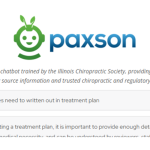
Increasing Patient Referrals to Your Practice

Some of the most successful practices in chiropractic thrive on patient referrals. They spend very little money on outside advertising and rarely do patient screenings. Instead, they are known as the go-to practice in the community. Developing a referral-based practice does not happen overnight, but there are some things that you can do to speed up the process.
It may go without saying, but make sure that patients are having a superb experience in your practice. It should be easy to book an appointment, financial policies should be clear, you should be listening to their concerns, conducting a detailed examination and customizing a treatment plan based on their goals. There should be periodic re-evaluations and a discharge from active care and into wellness care — whatever that looks like at your practice.
Let Your Patients Know the Plan
Having a start, middle and end to active care helps patients understand the larger concepts of what you are trying to accomplish with them. Be clear before the first examination of how many visits need to be completed and in what time frame. Let patients know what changes you expect to see in their symptoms and objective findings by the targeted time and what you will do if they don’t make progress. As you discharge patients, a clever way to ask for patient referrals is to tell patients that they have to find a replacement for their regular appointment time. It may sound silly, but it does work.
Your office doesn’t need to look like Fifth Avenue but does need to be up-to-date, clean and well maintained. If your existing patients aren’t impressed with your office, why would they send their friends and family there? It’s important for you to walk in the front door, sit in your reception chairs, lie on your own adjusting table and look for things that need to be cleaned, repaired or moved, to keep a professional appearance.
Educate Existing Patients
Many patients would refer others to you, but often mistakenly think you only treat whatever condition for which they came to you for help. The more you can educate your existing patient base on the variety of conditions you can help, the bigger the net you cast for patient referrals. This is an area where you can get really creative, and, depending on your time and resources, can really explode the size of your practice within six months to a year.
Make a list of six to twelve conditions that you enjoy treating and in which your treatment succeeded. Write a short synopsis of what the condition is, the common symptoms, why it occurs and what you can do to help. Although it takes time, I really suggest doing this yourself versus using canned information. It allows you to customize it to your practice and let your personality shine through. Next, take these condition briefs and publish them to your website. This serves as a resource for your current patients and for any potential patients browsing your website.
Create Flyers
Take the same information from your condition briefs and put them into a printed flyer form. You can decide on the rotation frequency (once a month, every two weeks, every week, etc.), and you can have these displayed in your office and hand them to patients as they come in for their appointments, letting them know you treat this condition and are happy to assist anyone they might know that is suffering with it.
If you enjoy public speaking, you can also hold a workshop on the condition you are featuring for the month. You can put an invitation for the event on the flyer, distribute it on Facebook and in any patient newsletters you might have. Make sure it’s clear that patients can attend and also invite friends or family who might be interested. In addition to in-person events, practices are now experimenting with putting their workshops online through Facebook Live or YouTube, so that more people can participate at a time convenient for them, expanding your reach. I also suggest charging a nominal fee for the workshop to increase the perceived value and to ensure they are attending if they RSVP.
Patient Newsletters
Having a regular patient newsletter is another avenue to let patients know what you can treat and to keep your practice at the top of their minds. If using an email format, frequency is key. Once a week seems to provide the best results. Keep articles informative and short, and drive patients to your website, YouTube channel or events. Even though everything is going online these days, you may also want to consider a quarterly print newsletter as well that gets mailed to your patient. Mailed newsletters may stand out more than your emailed ones and also reach those who are less electronically inclined. Just as with the condition briefs, I highly suggest you write your own newsletter content. Patients are highly discerning and can tell if material feels “canned.”
Although you cannot predict when and how it’s going to happen, keep your ears open as your patients mention others with health conditions or ask you questions about chiropractic care. Sometimes a good way to break the ice is to tell them about the success you are having with a particular patient case (keeping within privacy laws, of course). If you are treating a sciatica patient, maybe tell them about the relief your TMJ patient had that morning after getting adjusted. Rushing from patient to patient may be more efficient but doesn’t lend itself to getting to know them on a personal level. Find a balance that pays the bills and also allows you to develop a relationship.
Conclusion
Increasing patient referrals requires a plan, action steps, follow-through and time. Take a look at your current practice, and see how you can implement these ideas. Write down your plan, outline the action steps needed to get there, and make sure you follow through. Within a few months, you should be able to start measuring the results of your efforts. See what works best for you, and spend your time and money on what gives you the best return on investment. Before you know it, you’ll have a referral-based practice as well!

















